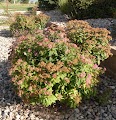Jane Rozum, Horticulture Agent, CSU Extension – Douglas County
I first want to thank all that responded to the Frozen III,
the CO-Hort blog article I wrote on 4/28/15. Your comments on the trees and
shrubs affected by last November’s Cold Snap were confirmation of the magnitude
of the problem. Willows, boxwoods, fruit trees, elms were mentioned by readers as
trees and shrubs that hadn’t yet recovered in your landscapes by the end of
April.
 |
| Dead hedge July 2015 |
Our ‘wait and see’ recommendation about whether plants would recover
from the sudden November 2014 temperature plunge was again thwarted by another
ill-timed frost. On Mother’s Day 2015, many areas around the Front Range
received snow and temperatures below 26 degrees F. This occurred while some
trees and shrubs were in a critical stage of leafing out, and much of the new
growth froze and turned brown. Ash, Honeylocust, Hackberry and Maple were among
trees where new growth froze in Douglas County; other trees and shrubs could
have been affected in your locale. While I’m happy to report that many trees
re-leafed in my area, there are still trees and shrubs that did not or had areas
in the canopy that had poor growth.
 |
 |
| Freeze injury (left) and regrowth 2 weeks later (above) |
  |
| April 2015 (left) same shrub July 2015 (right) |
Second, I’d like to preface my comment with a very small botany lesson. Plants need leaves so that photosynthesis can occur: Energy from the sun is converted to energy that the plant needs to grow. So, it stands to reason that without leaves, photosynthesis doesn’t occur and therefore the plant cannot provide the necessary nutrients for survival. If there is no food, plant tissue will die. I’m going to go out on a limb (no pun intended!) and say if your tree doesn’t have leaves now, the landscape plant probably won’t leaf out. Plants don’t have the reserve energy stored in the roots to take a year off from growing; there is no long-term savings account of energy for plants. So, if your plant looks dead now, it most likely will remain that way.
 |
| Hibiscus, July 2015 with cold snap damage |
One question I’ve received is: There is sucker growth from
the base of the trunk, but no growth in the canopy, is my tree O.K?
Unfortunately, the sucker growth is the tree’s last ditch effort at survival.
Since many landscape trees (especially fruit trees) are grafted onto hardy root
stock, suckers from the root stock will not have the same ornamental
characteristics as the original tree. If the canopy did not leaf out, it probably
won’t.
Still not sure whether your tree or shrub is viable? There
are people you can contact to check this out. First, call your local Extension
office and ask to speak with a Colorado Master Gardener or Horticulture professional.
They can examine photos of your landscape plant and offer some advice on your
situation. Find your county office information here. Some offices along the Front Range have ‘tree teams’ that will send out
trained CMGs for a consultation (for a fee).
You can also have a
Certified Arborist come and evaluate your landscape plants. Many Extension offices
have lists of local International Society of Arborists (ISA) that will consult
and will also prune/remove trees and shrubs. This is also a fee-based service.
Are the trees and shrubs that survived the storms now safe?
Unfortunately, there is no crystal ball that can tell us. These weather events
were stressors to the plants and though they survived thus far, it does not
mean that they will survive another ill-timed storm. We've had many stressful weather events before the November Cold Snap (drought, etc.), and will continue to have weather-related landscape plant issues. Colorado’s weather is difficult
on trees and shrubs and, for that matter, the people that care for them.


No comments:
Post a Comment